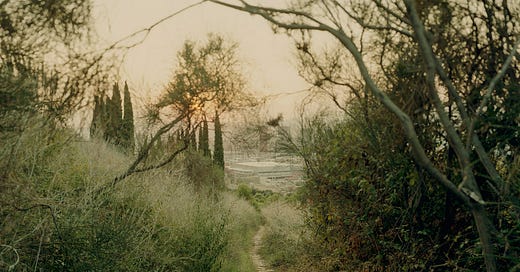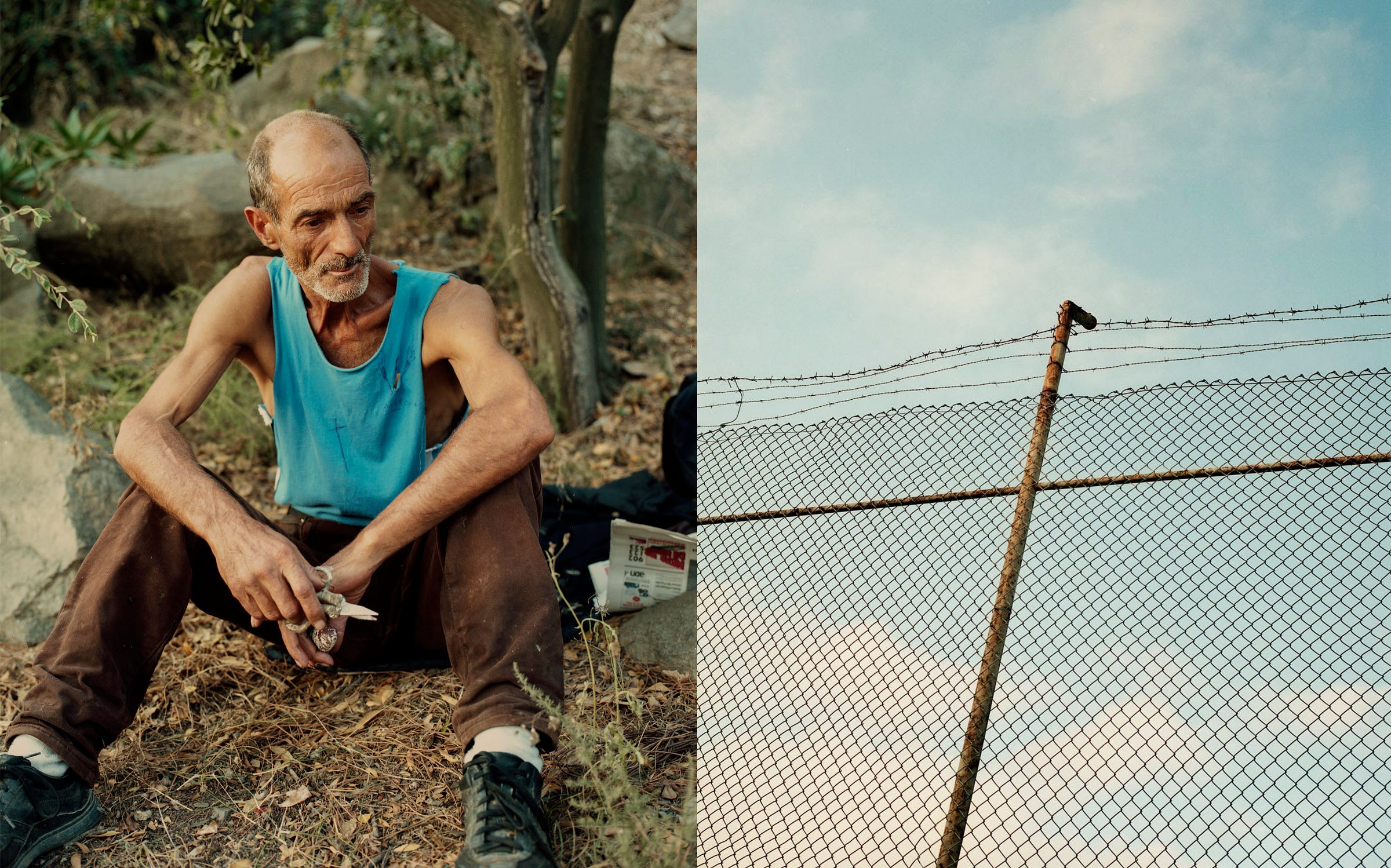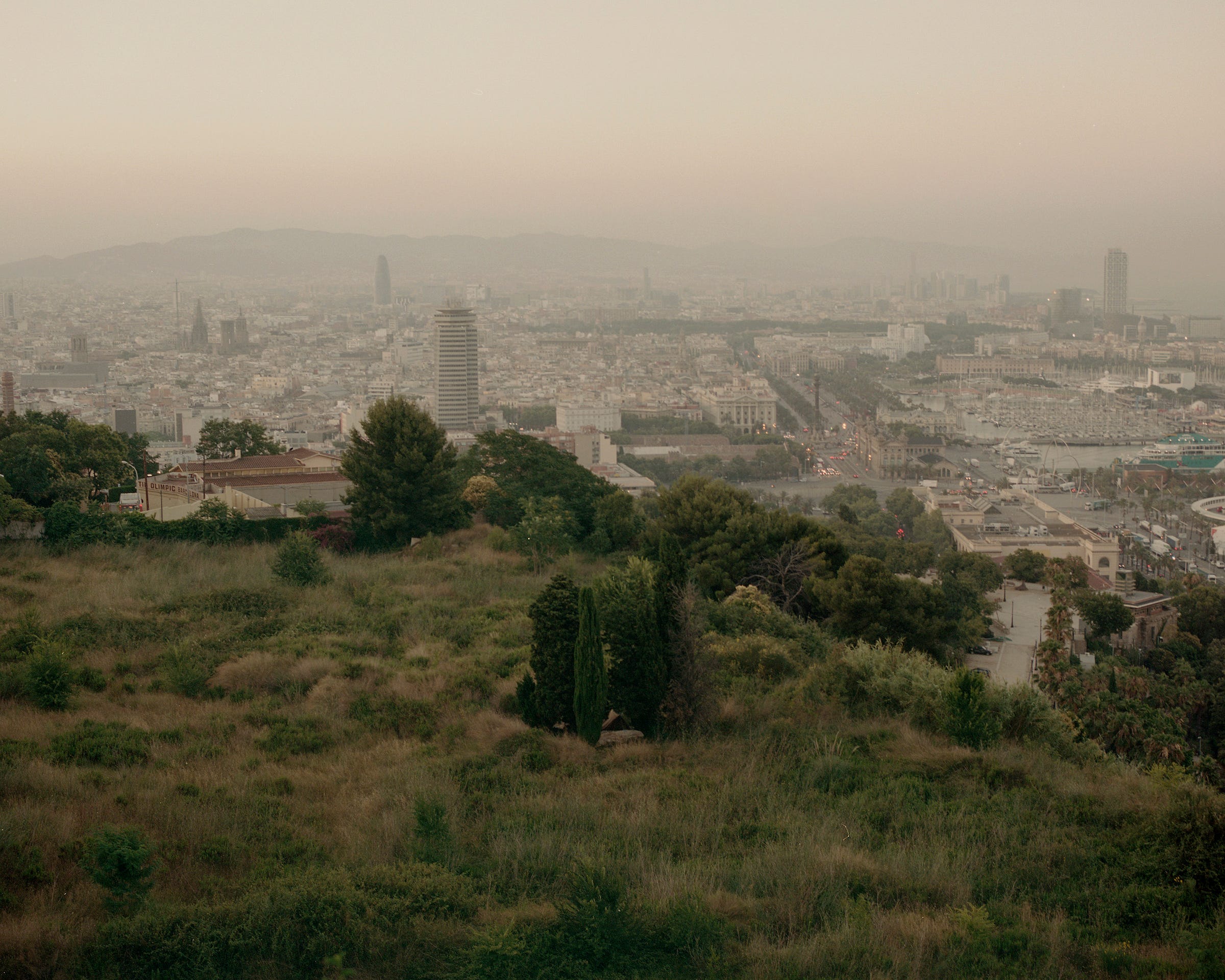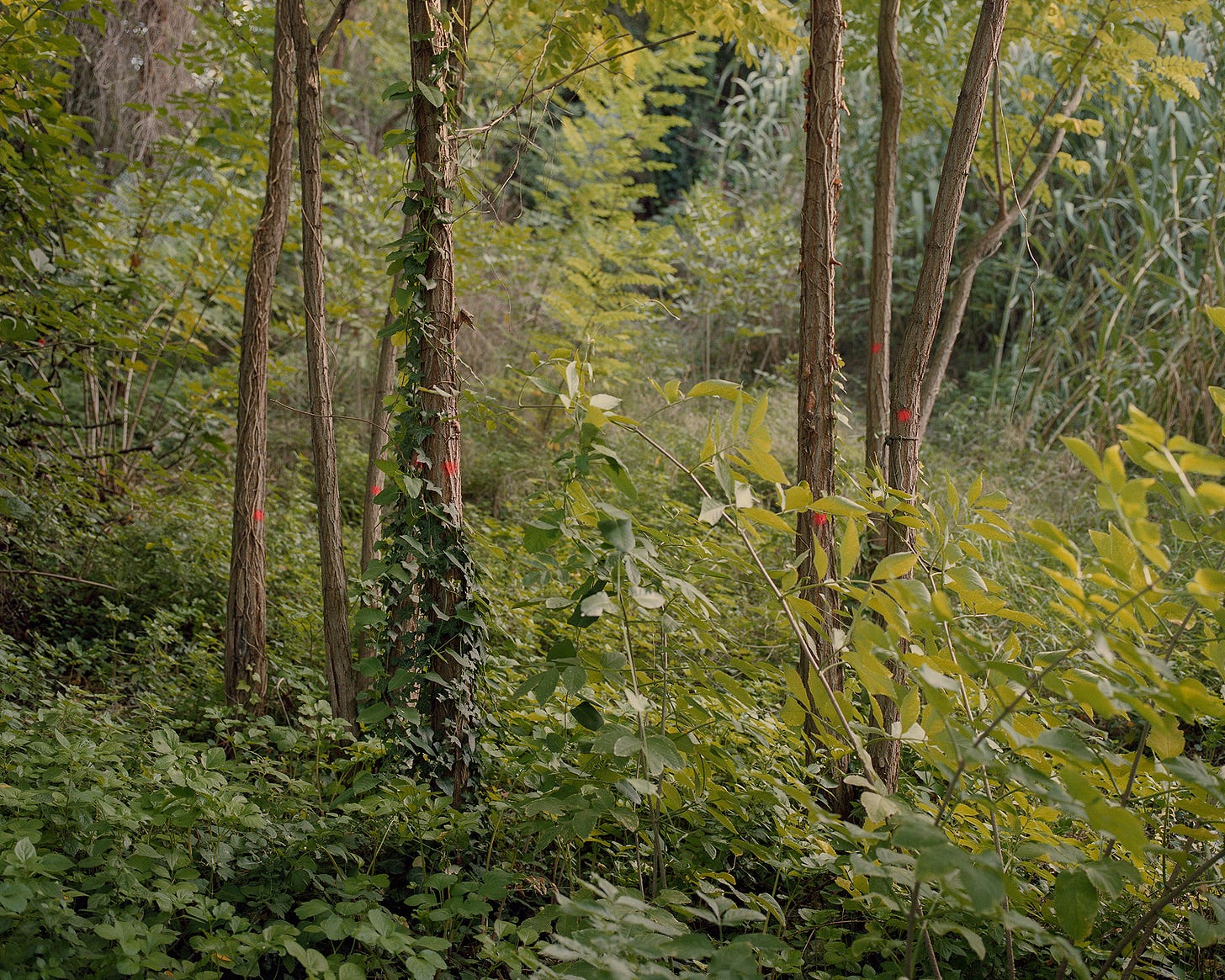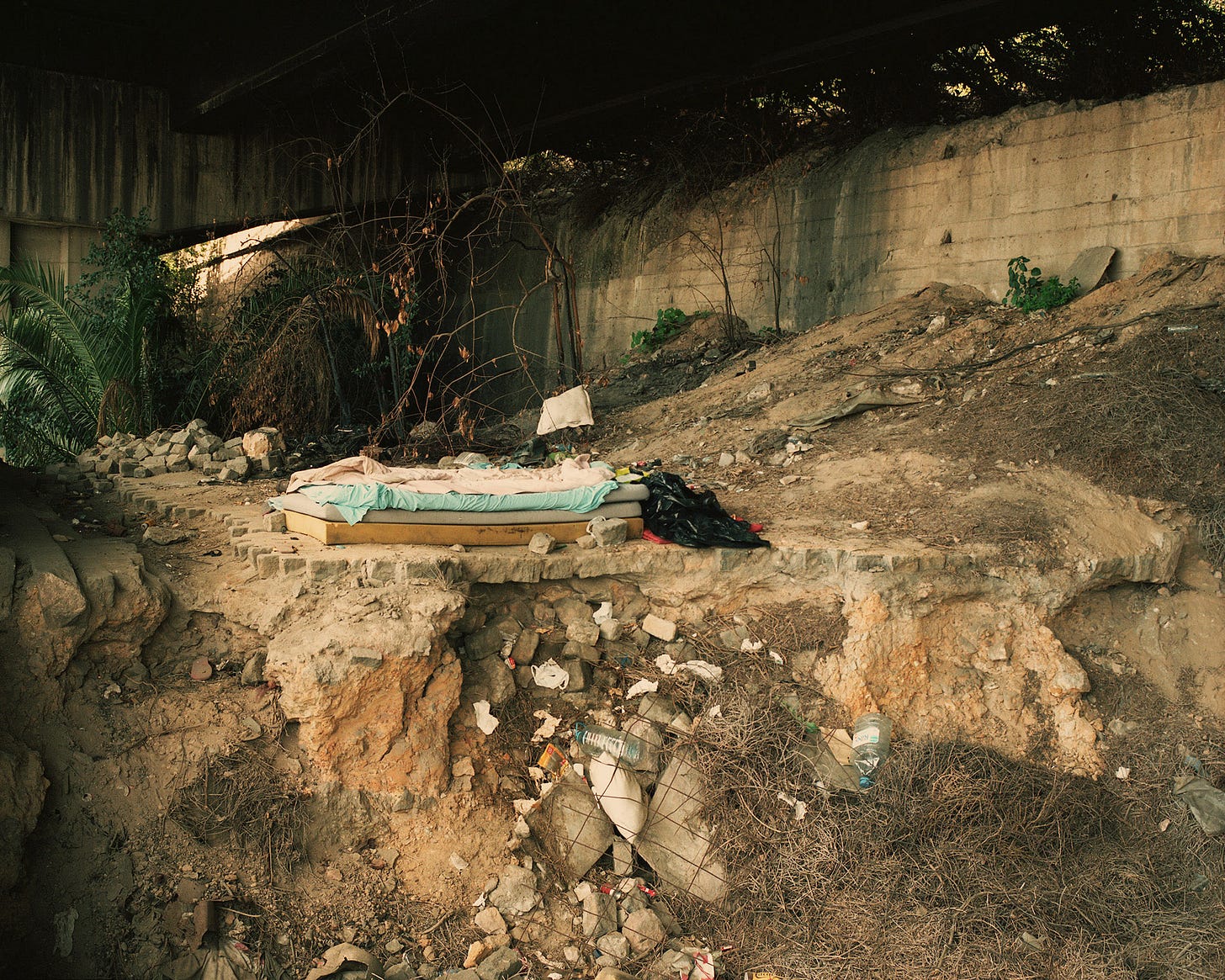Primero quiero expresar mi más sincero agradecimiento a aquellos cuyos consejos, aunque bienintencionados, me llevaron al fracaso. Lejos de ser errores, estos fracasos han sido escalones hacia el lugar en el que me encuentro ahora, un lugar por el que estoy profundamente agradecido. Aunque nunca sabré qué hubiera pasado si las cosas fuesen distintas, valoro cada tropiezo como una lección vital en mi camino.
Quisiera también pedir disculpas a Ignasi López, Carlos Albalá, Xavier Ribas, Jon Uriarte, o más recientemente a Yosigo, quienes dedicaron un valioso tiempo para ayudarme y enriquecer mi visión sobre la fotografía. Mi abrupta desaparición fue una decisión necesaria para comprender lo que no funcionaba en mí y en mi trabajo. Diez años después, creo haber hallado la respuesta.
Y un agradecimiento especial a Eloi Gimeno por su honestidad sin filtros.
Por allá en 2009, después de terminar 'Roig 26', mi primer y quizás único proyecto fotográfico a día hoy, comencé a preguntarme qué haría a continuación. Con una energía casi inagotable, debía empezar otro proyecto lo antes posible. En esa misma época, recibí una beca para un curso en la escuela Grisart de Barcelona, dedicada a la fotografía. El curso, de un año de duración, se enfocaba en proyectos personales o de autor. Lo que primero me llamó la atención de este curso (que creo ya no existe como tal) era que la fotografía parecía secundaria; lo importante era definir un concepto y trabajarlo, cuanto más posmoderno, mejor.
Así me encontraba, dándole vueltas a cual sería mi siguiente paso. Se me ocurrieron algunas ideas, como ir al río Llobregat, (el principal rio de Cataluña) emulando el Mississippi de Alec Soth. Hice un par de incursiones en el Prat, pueblo donde discurre su desembocadura, pero pronto me pareció inabarcable, ya que mi idea era hacer todo su recorrido a pié. Pensé en otras ocurrencias, pero todo me pareció un poco forzado. Así que, a mitad de curso, después de mucho pensar y poco disparar, terminé por editar las fotos de mis abuelos con ayuda de los profesores, así sacaba algo de provecho a la beca. Creo que después de este curso, la mayoría de los alumnos perdieron las ganas de sacar fotos y muchos acabaron por abandonar la fotografía. Uno de los peligros de estudiar fotografía es que a veces, hay cosas se deberían quedar como puro hobby y no complicarlas demasiado. Pero esos ya son otros temas y quizás más adelante me meta en ese jardín.
Al finalizar del curso, me encontraba en una encrucijada, indeciso sobre mi próximo proyecto. Mis expectativas eran altas; ansiaba superar el éxito de aquel primer proyecto dedicado a mis abuelos que tantas satisfacciones me había brindado. Buscaba crear algo que resonara con el público, algo que me abriera las puertas de galerías y exposiciones, consolidando mi presencia en el mundo de la fotografía contemporánea. Solo una cosa estaba clara: continuaría explorando el estilo y la narrativa del 'nuevo documental'. Quería emular a fotógrafos como Robert Adams, Alec Soth, Mark Steinmetz, Joel Sternfeld, Stephen Shore, Xavier Ribas, John Gossage, Michael Smith o Paul Graham. Este enfoque emergió tras la crisis del fotoperiodismo, momento en el que la perspectiva objetiva, tradicionalmente asociada a la fotografía como documento gráfico, colapsó. De sus cenizas surgió una fotografía de estética similar pero diferenciada por su enfoque subjetivo. En el ‘nuevo documental', los fotógrafos fusionan sus percepciones personales con la realidad capturada, creando narrativas visuales que van más allá de la objetividad del fotoperiodismo clásico. Este enfoque permite una interpretación introspectiva y artística, explorando temas sociales y culturales a través de un lente subjetivo y reflexivo.
Personalmente, me inclinaba más hacia los fotógrafos americanos que los europeos. Mientras los europeos a menudo infundían sus obras con mensajes políticos o activismo, los americanos, o mejor dicho, los estadounidenses, se sumergían en su propia mitología e imaginario: la búsqueda del oeste, las gasolineras, personajes perdidos en montañas, moteles y carreteras interminables. Su arte capturaba un romanticismo melancólico, transformando lo cotidiano en escenas que reflejaban la esencia de la vida y los sueños americanos.
Así que, un buen día, caí que pronto se cumplirían 20 años de las olimpiadas de Barcelona’92 y pensé que sería interesante dar un paseo por la montaña de Montjuic, lugar donde se construyeron gran parte de las instalaciones olímpicas, para ver cómo había cambiado el panorama. Inicialmente, me concentré en recorrer la zona olímpica y los jardines que se habían desarrollado a su alrededor. Sin embargo, mi interés se desplazó rápidamente hacia los márgenes. Más allá de los estadios y museos, detrás de los hermosos jardines, comenzaba la maleza y el entorno se tornaba cada vez más salvaje. La montaña escondía una cara oculta, algo que abrió rápidamente mi curiosidad. De allí el nombre del proyecto, esa cortina verde que divide lo controlado, lo humano, de la naturaleza más salvaje, esas dos fuerzas que Nietzsche describe en ‘El nacimiento de la tragedia’ cómo lo Apolíneo y lo Dionisíaco.
En aquella época, me encontraba profundamente obsesionado y enamorado de la fotografía, experimentando con mis nuevas cámaras, asistiendo a talleres, conferencias, encuentros, yendo a festivales y gastando todo mi dinero en fotolibros. Fue en uno de estos talleres donde visité Menorca por primera vez. El curso era impartido por uno de mis fotógrafos españoles favoritos, Xavier Ribas, un antropólogo convertido a artista. Me gustaba especialmente su trabajo 'Domingos', realizado en los 90’s que captura escenas cotidianas del extraradio barcelonés. Esta experiencia no solo me brindó la oportunidad de explorar Menorca, una isla que terminé amando y que ahora es un pilar central en mi vida, sino también de conocer a Xavier de primera mano. Él fue uno de los primeros a quienes consulté sobre los bocetos iniciales de lo que se convertiría en 'La cortina verde'. Xavier pasó a ser es una especie de tutor que me iba aconsejando mientras el proyecto evolucionaba. Además, cada visita a su casa era toda una experiencia ya que seguramente tenga una de las bibliotecas privadas sobre fotografía más completas de España. Muchos de los libros del difunto proyecto que tenía junto a Yosigo, ‘Have a Nice Book’ salieron de allí.
Desde 2010 hasta 2014, visité recurrentemente la montaña. En este lugar, los extremos convivían: a pocos metros de uno de los hoteles más lujosos de la ciudad, había un campamento de personas sin hogar, cuevas habitadas y zonas boscosas donde se practicar cruising. Al no ser yo, muy aventurero, mi aproximación a este mundo fue lenta y cautelosa, casi a escondidas. Solo en contadas ocasiones me atreví a acercarme a esos habitantes para pedirles algún retrato. Recuerdo con temor cruzar ese umbral donde el jardín ordenado se convertía en maleza salvaje. La adrenalina se disparaba al entrar en ese lugar donde confluyen todo tipo de desechos de nuestra sociedad próspera y rica, desde las personas sin hogar, todo tipo de residuos, hasta la planta silvestre que escapaba al control de los jardineros.
Muchos colegas me ayudaron y aconsejaron. Mi idea final era sacar un libro y, en este sentido, Carlos Albalá e Ignasi López me brindaron la oportunidad de publicarlo en su editorial, Bside Books. Empezamos a trabajar en el concepto del libro, así que comencé a investigar más sobre la historia de Montjuic. La montaña sigue siendo un lugar verde, principalmente por su posición estratégica de defensa (y ataque) de la ciudad. Al ser una zona anteriormente militarizada, no se permitió urbanizar. Tanto a Xavier Ribas como a Ignasi López les interesaba mucho esta mirada política de cómo el poder transforma el territorio y lo controla. De repente, me vi envuelto en un enjambre de conceptos que sonaban muy bien y tenían mucho sentido, pero que, de alguna manera, sentía que no era lo que yo buscaba paseando por Montjuic, empezaba a intuir que algo no andaba bien.
Al mismo tiempo, contacté con el diseñador Eloi Gimeno. Eloi, reconocido por ser uno de los mejores diseñadores de fotolibros. Tenía una peculiar manera de trabajar, totalmente distinta a la de otros diseñadores que he conocido. Empezó a acompañarme en mis excursiones a la montaña, se metía en mi cabeza casi como un parásito. Después de unos meses, me dijo una frase que recordaré toda la vida:
“Te voy a diseñar el libro, pero que sepas que me parece una puta mierda.”
He tardado más de diez años en recuperarme de la hostia que me llevé.
Lo dejo de momento aquí, seguiré en una segunda entrega.
El proyecto apareció en diversos medios, seleccionado en algún que otro festival e incluso los de Vice hicieron un video.
Artículo en El Periódico.
En 2012 fué seleccionado en ‘Talent Latent’ dentro de Scan, uno de los festivales de fotografía más importantes a nivel español. Aquí se puede conseguir el catálogo.
Apareció en algún que otro magazine online cómo Thisispaper, Formagramma o Phases Magazine.
First, I want to express my sincere thanks to those whose well-intentioned advice, albeit unknowingly, led me to failure. Far from being mistakes, these failures have been stepping stones to where I am now, a place for which I am deeply grateful. Although I will never know what might have happened if things had been different, I value each stumble as a vital lesson on my path.
I would also like to apologize to Ignasi López, Carlos Albalá, Xavier Ribas, Jon Uriarte, or more recently to Yosigo, who dedicated their valuable time to help me and enrich my vision of photography. My abrupt disappearance was a necessary decision to understand what wasn't working in me and in my work. Ten years later, I believe I have found the answer.
And special thanks to Eloi Gimeno for his unfiltered honesty.
Back in 2009, after completing 'Roig 26', my first and perhaps only photographic project to date, I started to wonder what I would do next. With almost inexhaustible energy, I needed to start another project as soon as possible. Around that time, I received a scholarship for a course at the Grisart School in Barcelona, which focused on photography. The course, lasting a year, was centered on personal or authorial projects. What first struck me about this course (which I believe no longer exists in its original form) was that photography seemed secondary; the important thing was to define a concept and work on it, the more postmodern, the better.
So there I was, pondering what my next step would be. I came up with a few ideas, like going to the Llobregat River, (the main river in Catalonia) emulating Alec Soth's Mississippi. I made a couple of excursions to the Prat, where it flows into the sea, but soon found it overwhelming, as my idea was to walk its entire course. I thought of other ideas, but everything seemed a bit forced. So, halfway through the course, after much thought and little shooting, I ended up editing photos of my grandparents with the help of the teachers, to get some benefit from the scholarship. I think after this course, most students lost the desire to take photos, and many ended up abandoning photography. One of the dangers of studying photography is that sometimes, there are things that should remain a pure hobby and not be overcomplicated. But those are other issues, and perhaps later I will delve into that garden.
At the end of the course, I was at a crossroads, undecided about my next project. My expectations were high; I longed to surpass the success of that first project dedicated to my grandparents that had brought me so much satisfaction. I was looking to create something that would resonate with the audience, something that would open the doors of galleries and exhibitions, consolidating my presence in the world of contemporary photography. One thing was clear: I would continue exploring the style and narrative of the 'new documentary'. I wanted to emulate photographers like Robert Adams, Alec Soth, Mark Steinmetz, Joel Sternfeld, Stephen Shore, Xavier Ribas, John Gossage, Michael Smith, or Paul Graham. This approach emerged after the crisis of photojournalism when the objective perspective, traditionally associated with photography as a graphic document, collapsed. From its ashes, a photography with a similar aesthetic but differentiated by its subjective approach arose. In the ‘new documentary', photographers merge their personal perceptions with the captured reality, creating visual narratives that go beyond the objectivity of classic photojournalism. This approach allows for an introspective and artistic interpretation, exploring social and cultural themes through a subjective and reflective lens. Personally, I leaned more towards American photographers than Europeans. While Europeans often infused their works with political messages or activism, Americans immersed themselves in their own mythology and imagery: the quest for the west, gas stations, motels, and endless roads. Their art captured a melancholic romanticism, transforming the everyday into scenes that reflected the essence of life and American dreams.
So, one fine day, I realized that the 20th anniversary of the Barcelona ’92 Olympics was approaching and thought it would be interesting to take a walk through Montjuic mountain, where many of the Olympic facilities were built, to see how the landscape had changed. Initially, I focused on touring the Olympic area and the gardens that had developed around it. However, my interest quickly shifted to the margins. Beyond the stadiums and museums, behind the beautiful gardens, the underbrush began, and the environment became increasingly wild. The mountain hid a hidden face, something that quickly sparked my curiosity. Hence the name of the project, that green curtain that separated the controlled, the human from the wildest nature, those two forces that Nietzsche describes in 'The Birth of Tragedy' as the Apollonian and the Dionysian.
At that time, I was deeply obsessed with and in love with photography, experimenting with my new cameras, attending workshops, conferences, meetings, going to festivals, and spending all my money on photobooks. It was at one of these workshops where I visited Menorca for the first time. The course was taught by one of my favorite Spanish photographers, Xavier Ribas, an anthropologist turned artist. I particularly liked his work 'Domingos', carried out in the 90s, capturing everyday scenes from the outskirts of Barcelona. This experience not only gave me the opportunity to explore Menorca, an island that I ended up loving and that now is a central pillar in my life, but also to meet Xavier firsthand. He was one of the first people I consulted about the initial sketches of what would become 'The Green Curtain'. Xavier became a kind of tutor who advised me as the project evolved. Additionally, every visit to his house was an experience as he surely had one of the most complete private photography libraries in Spain. Many of the books from the late project I had with Yosigo, ‘Have a Nice Book’, came from there.
From 2010 to 2014, I repeatedly visited the mountain. In this place, extremes coexisted: a few meters from one of the city's most luxurious hotels, there was a homeless camp, inhabited caves, and wooded areas where cruising was practiced. Not being very adventurous, my approach to this world was slow and cautious, almost secretive. Only on rare occasions did I dare to approach these inhabitants to ask for a portrait. I remember fearfully crossing that threshold where the orderly garden turned into wild underbrush. The adrenaline surged when entering that place where all kinds of waste from our prosperous and rich society converged, from the homeless people, all types of debris, to the wild plants that the gardeners periodically cut.
Many colleagues helped and advised me. My final idea was to publish a book and, in this regard, Carlos Albalá and Ignasi López offered me the opportunity to publish it with their publishing house, Bside Books. We began working on the concept of the book, so I started to delve deeper into the history of Montjuic. The mountain remains a green area, mainly due to its strategic position for the city's defense (and attack). Being a formerly militarized zone, urbanization was not permitted. Both Xavier Ribas and Ignasi López were very interested in this political perspective of how power transforms and controls the territory. Suddenly, I found myself wrapped up in a swarm of concepts that sounded very good and made a lot of sense, but somehow, I felt that it wasn't what I was looking for while walking through Montjuic, I began to sense that something was not quite right.
At the same time, I contacted the designer Eloi Gimeno. Eloi was known for being one of the best photobook designers. He had a peculiar way of working, totally different from other designers I've met. He started to accompany me on my excursions to the mountain, getting into my head almost like a parasite. After a few months, he said a sentence that I will remember all my life:
"I'm going to design the book, but just so you know, I think it's a piece of shit."
It's taken me more than ten years to recover from the blow I took.
I'll leave it here for now, and continue in a second installment.
The project appeared in various media, was selected in some festivals, and even Vice made a video about it.
There was an article in El Periódico.
In 2012, it was selected for 'Talent Latent', one of the most important photography festivals in Spain. The catalog can be obtained there.
It appeared in a few online magazines like Thisispaper, Formagramma or Phases Magazine.

